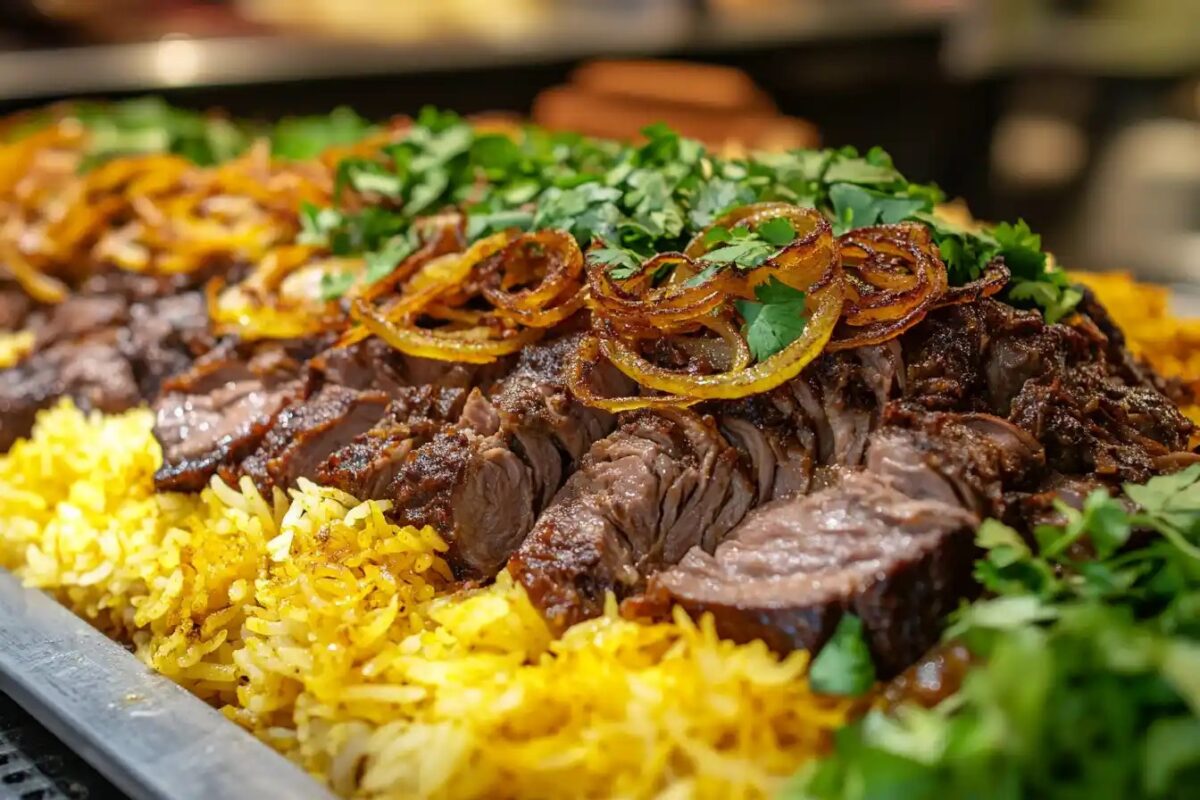Biryani and Breyani—two names that sound similar yet represent distinct culinary traditions. If you’ve ever wondered, “What is the difference between Biryani and Breyani?”, you’re not alone. While both dishes share common elements like fragrant rice, spices, and slow cooking, their origins, ingredients, and cooking techniques set them apart.
Biryani, a beloved dish from the Indian subcontinent, is known for its layered cooking method and rich spice blends. Breyani, on the other hand, is a South African adaptation, influenced by Cape Malay flavors and prepared differently.
In this article, we’ll explore their history, key ingredients, cooking styles, and cultural significance. Whether you’re a food enthusiast or just curious, this guide will help you appreciate the uniqueness of both dishes. Let’s dive in!
Introduction to Biryani and Breyani
The Global Love for Biryani and Breyani
Few rice dishes have captured hearts worldwide like Biryani and Breyani. These flavorful, spice-infused meals are cherished in India, Pakistan, Bangladesh, South Africa, and beyond. Their appeal lies in their aromatic rice, tender meat, and intricate layers of spices that create a mouthwatering experience.
However, many people mistakenly assume that Biryani and Breyani are the same dish, simply spelled differently. In reality, they have distinct regional influences, preparation methods, and ingredient lists.
Why Understanding the Difference Matters
If you’ve ever ordered a plate of Breyani in South Africa expecting the same dish as Indian Biryani, you might have been surprised by the difference. Understanding these distinctions is important not just for food lovers but also for chefs, travelers, and anyone exploring global cuisine.
Overview of the Article
This article will take you through:
✅ The origins and history of both dishes
✅ The key ingredients and cooking techniques
✅ The major differences between Biryani and Breyani
✅ Popular recipes and regional variations
✅ A detailed FAQ section answering common questions
By the end, you’ll know exactly what sets these dishes apart and which one you’d love to try next. Ready? Let’s start with Biryani!
Understanding Biryani
Origins and History of Biryani
Biryani, a dish deeply rooted in South Asian cuisine, has a fascinating history that dates back centuries. Many believe it originated in Persia and was brought to the Indian subcontinent by Mughal rulers. The dish evolved, incorporating local spices, meats, and cooking methods to create the various regional biryanis we enjoy today.
From Hyderabadi Biryani to Lucknowi Biryani, each variation has its unique touch. Some versions use Dum cooking, where the rice and meat are slow-cooked together, while others layer them separately to infuse deeper flavors.
Key Ingredients in Traditional Biryani
A perfect Biryani relies on high-quality ingredients, which include:
✅ Rice – Traditionally, Basmati rice is preferred due to its long grains and aromatic properties.
✅ Meat – Common choices are chicken, mutton, beef, and even fish.
✅ Spices – The heart of biryani lies in its blend of cardamom, cloves, cinnamon, bay leaves, star anise, and nutmeg.
✅ Saffron and Ghee – These add richness and a signature golden hue.
✅ Yogurt and Onions – Used to marinate the meat and enhance its tenderness.
For an in-depth look at Biryani spices and essential ingredients, check out this detailed guide on Quinto Recipes.
Types of Biryani Across India and the World
Biryani isn’t just one dish—it has regional varieties that reflect local traditions. Here are some famous types:
- Hyderabadi Biryani – Rich, spicy, and cooked in the Dum style.
- Lucknowi Biryani – More delicate and fragrant, with a Mughlai touch.
- Kolkata Biryani – Contains potatoes and has a milder, sweeter taste.
- Pakistani Biryani – Often spicier and includes tomatoes for extra tanginess.
Traditional Cooking Methods of Biryani
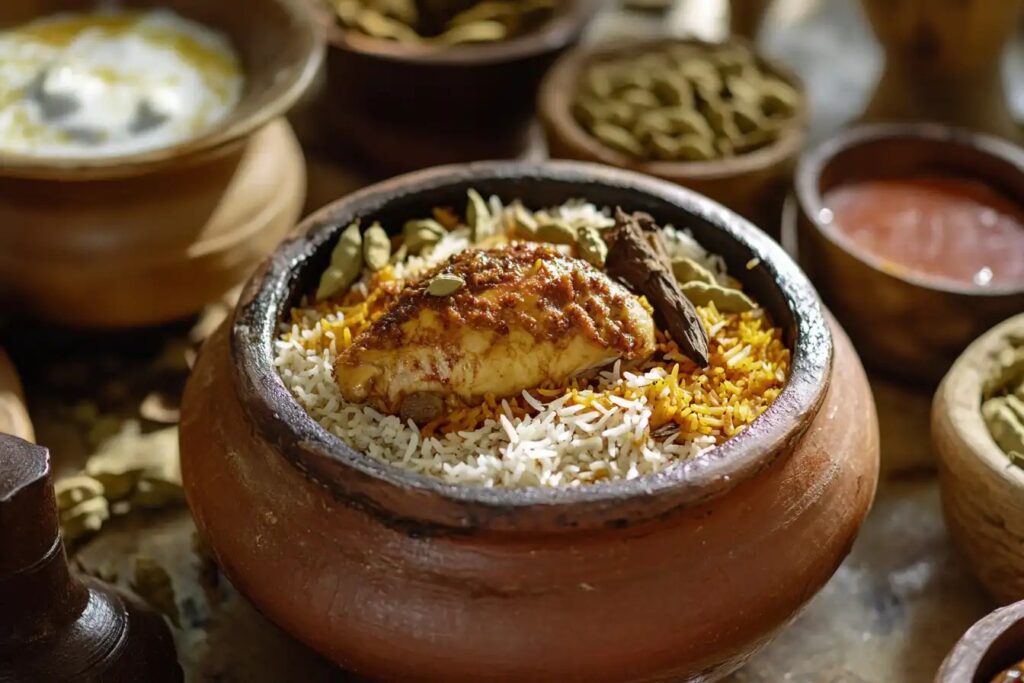
Biryani is prepared using two primary techniques:
1️⃣ Dum Cooking – The meat and partially cooked rice are layered and slow-cooked in a sealed pot to trap the flavors.
2️⃣ Pukki Biryani – The rice and meat are cooked separately before being combined.
The secret to a perfect biryani lies in the layering technique and the balance of spices. If you’re curious about the key ingredient that enhances the dish’s taste, read this insightful article.
Understanding Breyani
Origins and History of Breyani
Breyani, the South African counterpart of Biryani, traces its roots back to Malay and Indian immigrants who brought the dish to the Cape during the colonial era. Unlike its South Asian relatives, Breyani evolved to include local flavors, ingredients, and cooking styles, making it a staple in Cape Malay cuisine.
One major distinction? Breyani is often spicier, more rustic, and includes lentils to add extra texture. It is a special dish served at festivals, weddings, and family gatherings.
How Breyani Differs in South African Cuisine
South African Breyani stands out because of its unique blend of local ingredients:
- Parboiled Rice – Unlike Basmati rice, which is common in Biryani, Breyani often uses parboiled or brown rice.
- Lentils – A signature ingredient, adding protein and texture.
- Meat Choices – Chicken and mutton are preferred, but fish and beef are also used.
- Spices – Similar to Biryani but with a heavier use of turmeric, bay leaves, and garam masala.
For a delicious South African Chicken Breyani recipe, check out this step-by-step guide.
Key Ingredients in Breyani Recipes
A traditional Breyani recipe typically includes:
✅ Rice and Lentils – Cooked separately before being mixed.
✅ Marinated Meat – Usually mutton or chicken, infused with garlic, ginger, and spices.
✅ Onions and Tomatoes – Create a flavorful base known as masala.
✅ Potatoes – A must-have addition that soaks up the flavors.
Traditional Cooking Methods of Breyani
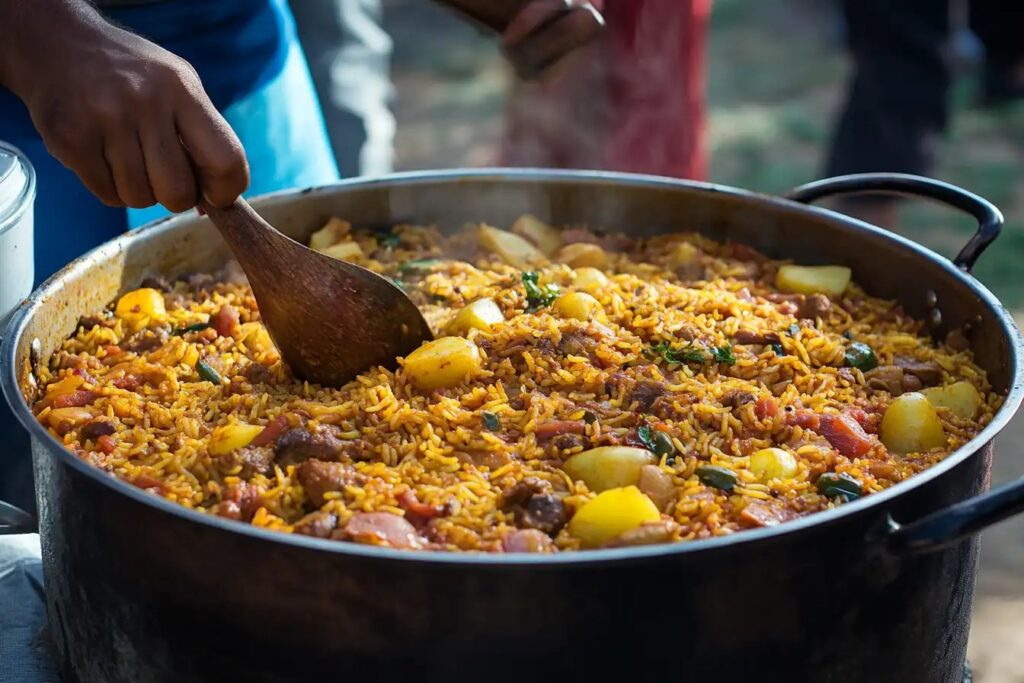
Unlike Biryani’s layered Dum cooking, Breyani is prepared using the one-pot method, where ingredients are slow-cooked together. This technique ensures that the flavors meld beautifully, resulting in a hearty, comforting meal.
Another notable difference? Breyani is often baked in an oven rather than cooked on a stovetop.
💡 Want to know what makes Breyani spice mix special? Read this detailed breakdown.
Key Differences Between Biryani and Breyani
What is the Difference Between Biryani and Breyani?
Many food lovers often wonder, “What is the difference between Biryani and Breyani?” While both dishes share similarities, their ingredients, cooking techniques, and cultural influences set them apart.
Biryani is an Indian subcontinent dish, rich in flavors, prepared with fragrant Basmati rice, and often layered using the Dum cooking method. Breyani, on the other hand, is a South African adaptation, incorporating parboiled rice, lentils, and Cape Malay spices in a single-pot preparation.
Let’s break down the key differences further.
Difference in Ingredients and Spices
Biryani:
- Uses Basmati rice, giving it a long-grain, fluffy texture.
- Incorporates saffron, garam masala, and whole spices for depth of flavor.
- Often includes yogurt-based marinades for the meat.
Breyani:
- Uses parboiled rice, which has a firmer texture.
- Contains turmeric, bay leaves, and a Cape Malay spice mix for a unique taste.
- Often includes lentils and potatoes, which are uncommon in traditional Biryani.
For an in-depth guide to Biryani’s secret ingredients, check out this article.
Cooking Techniques: Layered vs. Mixed Method
One of the biggest distinctions is the preparation method.
- Biryani is traditionally layered with partially cooked rice and marinated meat, then slow-cooked using Dum (sealing the pot with dough).
- Breyani, however, follows a one-pot approach, where all ingredients—including rice, meat, and lentils—are cooked together, giving it a more homogeneous texture.
Regional and Cultural Influences
- Biryani has deep roots in Mughlai, Persian, and South Asian cuisine, with numerous regional variations like Hyderabadi, Lucknowi, and Kolkata Biryani.
- Breyani is an integral part of South African Cape Malay cuisine, brought by Indonesian and Indian immigrants during the colonial era.
Variations in Taste and Texture
- Biryani has a richer, more aromatic taste, with separate layers of rice and meat.
- Breyani has a more uniform taste, thanks to the one-pot cooking method.
If you’re interested in making traditional South African Chicken Breyani, check out this step-by-step recipe.
Serving Styles and Accompaniments
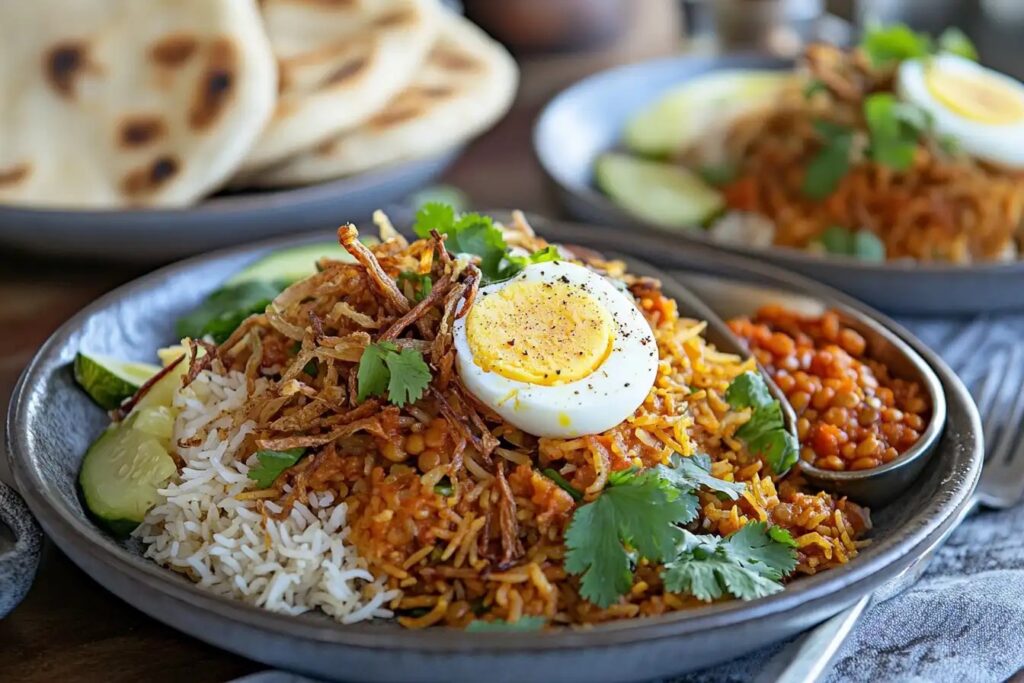
- Biryani is often served with raita (yogurt sauce), boiled eggs, or salan (gravy-based curry).
- Breyani is typically paired with sambal (spicy relish) and pickled vegetables.
Both dishes have their unique charm, making them beloved worldwide.
Comparing Biryani and Other Similar Dishes
Biryani vs. Akni: What’s the Difference?
Akni, another South African dish, is often confused with Biryani and Breyani. However, there are notable differences:
- Akni is a simpler, less layered version of Breyani, where rice and meat are cooked together with fewer spices.
- Unlike Biryani, Akni does not require Dum cooking.
- It’s a quicker meal and often enjoyed as an everyday dish, while Biryani and Breyani are considered more festive foods.
Biryani vs. Pulao: Similarities and Distinctions
Biryani and Pulao both involve rice and meat cooked with spices, but they have distinct differences:
- Pulao is a one-pot dish, where rice and meat are cooked together, similar to Breyani.
- Biryani involves layering and requires more intricate spice blends.
- Pulao is often milder in taste compared to the bold flavors of Biryani.
Biryani vs. Breyani vs. Pilaf: A Quick Comparison
If you’re still wondering what is the difference between Biryani and Breyani?, here’s a quick comparison:
| Dish | Region | Cooking Method | Key Ingredients | Texture |
|---|---|---|---|---|
| Biryani | India, Pakistan | Dum (Layered) | Basmati rice, saffron, whole spices | Aromatic, separate layers |
| Breyani | South Africa | One-pot | Parboiled rice, lentils, turmeric | Uniform, spicy |
| Pilaf (Pulao) | Middle East, Central Asia | One-pot | Rice, stock, vegetables, meat | Mild, lightly spiced |
Each dish has its own unique identity, offering a delicious experience in its own way.
For more delicious rice-based dishes, check out Quinto Recipes for inspiration!
Popular Biryani and Breyani Recipes
Classic Indian Chicken Biryani Recipe
Want to enjoy the authentic flavors of Biryani? This Indian Chicken Biryani recipe is a great place to start!
Ingredients:
- 2 cups Basmati rice
- 500g chicken, cut into pieces
- 1 cup plain yogurt
- 2 large onions, sliced
- 2 tomatoes, chopped
- 2 tbsp ginger-garlic paste
- 1/2 cup milk with saffron strands
- Whole spices (bay leaves, cardamom, cloves, cinnamon)
- 2 tbsp ghee
- 1 tbsp garam masala
- Salt to taste
Cooking Instructions:
1️⃣ Rinse the Basmati rice and soak for 30 minutes.
2️⃣ Marinate the chicken in yogurt, ginger-garlic paste, and spices for at least an hour.
3️⃣ Fry onions in ghee until golden brown. Set some aside for garnish.
4️⃣ Cook the marinated chicken with tomatoes and spices until tender.
5️⃣ Boil the rice until 70% cooked, then drain.
6️⃣ In a pot, layer the cooked chicken and rice, adding fried onions and saffron milk between layers.
7️⃣ Seal the pot and cook on low heat for 20 minutes.
Serve hot with raita (yogurt sauce) and salad!
Traditional South African Breyani Recipe
If you prefer South African Breyani, here’s a flavorful recipe:
Ingredients:
- 2 cups parboiled rice
- 500g mutton or chicken
- 1/2 cup lentils
- 2 potatoes, cubed
- 2 tbsp Breyani spice mix
- 1 large onion, sliced
- 2 tbsp butter or oil
- 1 tsp turmeric
- 2 cups chicken stock
Cooking Instructions:
1️⃣ Rinse the rice and lentils. Soak them separately for 30 minutes.
2️⃣ In a pot, heat butter and fry onions until golden brown.
3️⃣ Add meat, spices, and cook until well-browned.
4️⃣ Stir in lentils, potatoes, and stock. Cook for 10 minutes.
5️⃣ Add the rice and mix well. Cover and simmer for 30 minutes.
Enjoy Breyani with sambal (spicy relish) and chutney!
Want to explore more Biryani and Breyani recipes? Check out Quinto Recipes for inspiration!
FAQs
Is it Breyani or Biryani?
Both names refer to spiced rice dishes but belong to different cuisines. Biryani is the Indian version, while Breyani is its South African adaptation.
What is the Difference Between Biryani and Breyani?
This is one of the most common questions! The main differences lie in:
✅ Cooking method – Biryani is layered; Breyani is a one-pot dish.
✅ Rice type – Biryani uses Basmati rice, while Breyani often includes parboiled rice and lentils.
✅ Flavors – Biryani has fragrant, layered spices, while Breyani is more rustic and spicier.
What is the Meaning of Biryani?
The word Biryani comes from the Persian word birian, meaning “fried before cooking”, referring to the traditional preparation method.
How Does Breyani Differ From Akni?
Both are South African rice dishes, but Akni is less complex and uses fewer spices. It’s more of a quick, everyday meal compared to the festive Breyani.
For more Biryani and Breyani tips, check out Quinto Recipes.
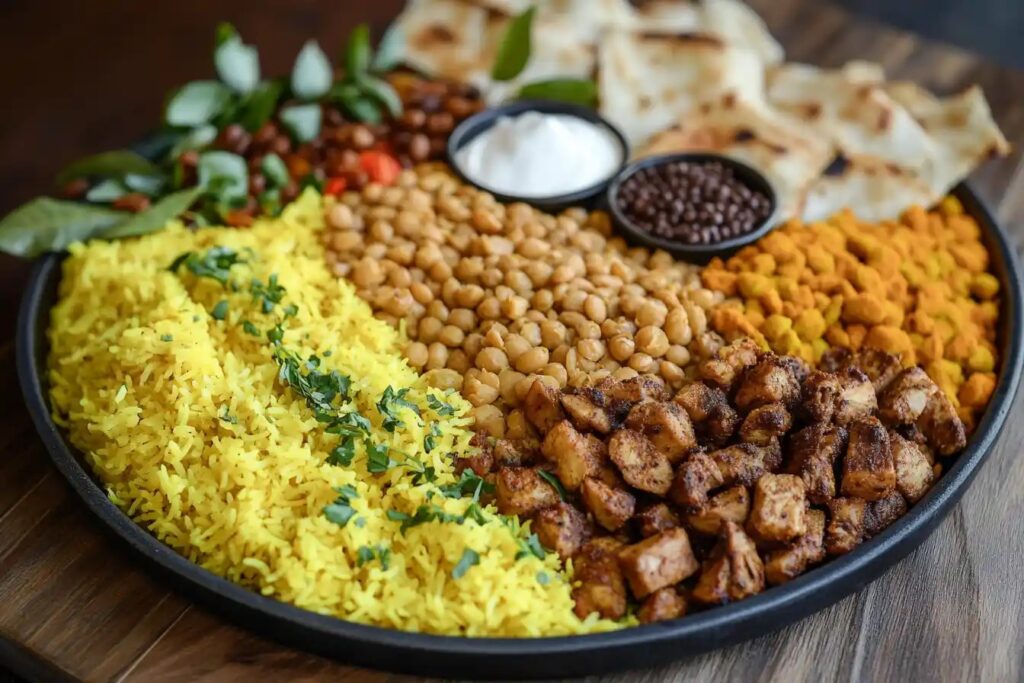
Conclusion
Now that we’ve explored the key question—“What is the Difference Between Biryani and Breyani?”—it’s clear that these two beloved dishes, while sharing some similarities, have distinct origins, ingredients, and cooking styles.
✅ Biryani, a South Asian delicacy, is known for its layered cooking method, fragrant Basmati rice, and rich spice blends. It has multiple regional variations, each with its own unique twist.
✅ Breyani, a South African adaptation, embraces parboiled rice, lentils, and Cape Malay spices, using a one-pot cooking technique that creates a hearty and comforting meal.
Both dishes celebrate culture, tradition, and flavor, making them staples in their respective cuisines. Whether you prefer the layered elegance of Biryani or the bold, spiced depth of Breyani, both are worth experiencing.
If you’re eager to try these dishes at home, check out our authentic Breyani recipe or discover the secret ingredient that makes Biryani so special here.
So, next time you’re craving a flavorful rice dish, will it be Biryani or Breyani? Either way, you’re in for a delicious feast! 🍛🔥
